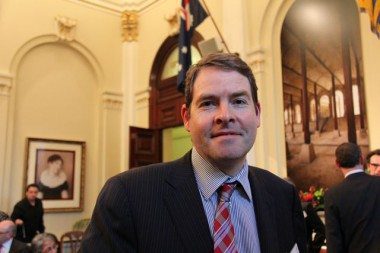Oliver Yates has revealed plans to retire as chief of the federal government’s Clean Energy Finance Corporation, nearly four years after he was appointed by the then Gillard government as the green bank’s founding CEO.

The news was announced by the CEFC on Wednesday, who said Yates would remain on in an interim role until a suitable replacement was found – the board has reportedly begun the process of recruitment and is considering both internal and external candidates.
As we reported back when his appointment to the role was first confirmed, Yates came the CEFC from a 20-year career at Macquarie Group, where he was involved in corporate advisory, financial structuring, project finance, debt structuring, equity raising and listings, with many years experience in clean energy.
In his time at the CEFC, which started its life with a $10 billion kitty, the bank’s investment commitments have reached $2.3 billion, contributing to projects with a total value of $5.7 billion, and steering Australia’s renewable energy industry through extended periods of policy uncertainty and resulting investment drought.
Yates’ tenure was also punctuated by periods of serious political hostility, particularly under the prime ministership of Tony Abbott, whose ultraconservative Coalition government repeatedly tried to have the CEFC, along with the Australian Renewable Energy Agency, abolished. In Opposition, they even threatened to not honour the contracts the bank would write.
Yates, however, always managed to remain calm and measured in his responses.
“There is no basis to claims that the CEFC is providing ‘low cost high risk loans’ that ‘no other financial institution would provide’ or that we are a ‘lender of last resort’,” he told RenewEconomy in an interview in May 2013.
“The whole concept of the CEFC was to provide stability and independent market-based decision making for financing development of the clean energy sector. The CEFC’s approach is to invest commercially and achieve self-sufficiency. This means that our impact on the Budget and specifically the Underlying Cash Balance is limited,” he added.
As we reported here in July, the CEFC has also achieved a 73 per cent year-on-year increase in the value of new investment commitments, including a substantial increase in the number of indirect investments and new capital products, demonstrating the growing strength and breadth of its co-financing models.
“Mr Yates’ dedication, energy and experience have played a critical role in the CEFC’s development, investment performance and its market position as a sector specific investor and as an effective tool of public policy,” said CEFC chair Jillian Broadbent in a statement on Wednesday.
“He has made a significant contribution to the sector and departs on excellent terms. He leaves a strong team and organisation which will continue its task to catalyse the flow of funds into emissions reduction investments.”

Yates, himself, said the decision to leave the CEFC had been difficult, but that the timing was right.
“I want to hand the baton to the next CEO knowing the CEFC has never been stronger,” he said in a statement. “The CEFC is now well established, with a robust pipeline of transactions, and a great team of specialists, with the strong support of the clean energy sector.
“With the Paris agreement to limit the rise in global temperatures to below two degrees Celsius becoming binding, Australia’s clean energy investment market will continue to accelerate, requiring us to run even faster.
“Working with the Board to establish the CEFC has been an amazing opportunity. It has been a complex and challenging few years, which I have found extremely satisfying. I deeply appreciate the support I have received from the Board and my team at the CEFC and I know the organisation will continue to go from strength to strength.”
In accordance with the CEFC Act, the new CEO will be appointed by the CEFC Board, following consultation with the responsible ministers.








